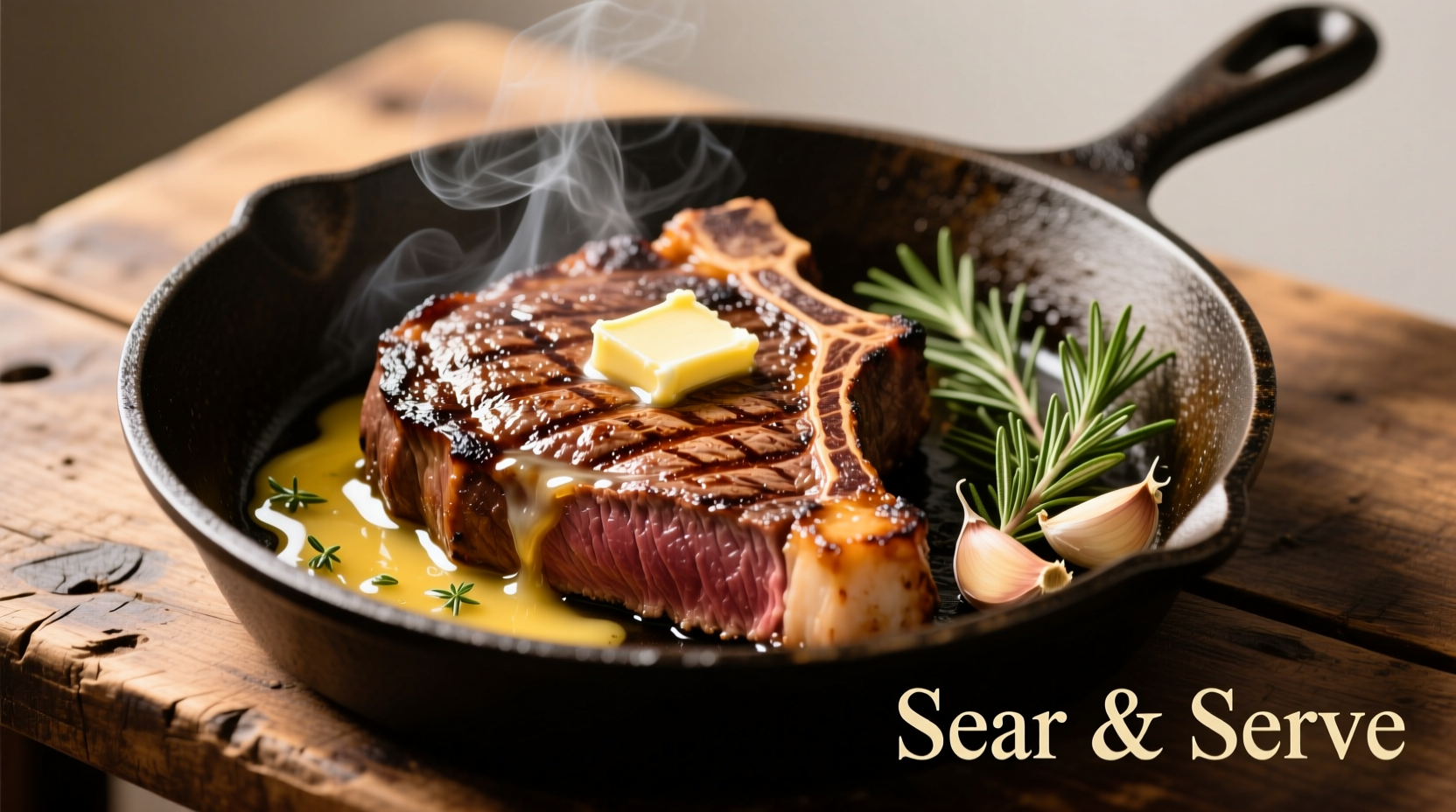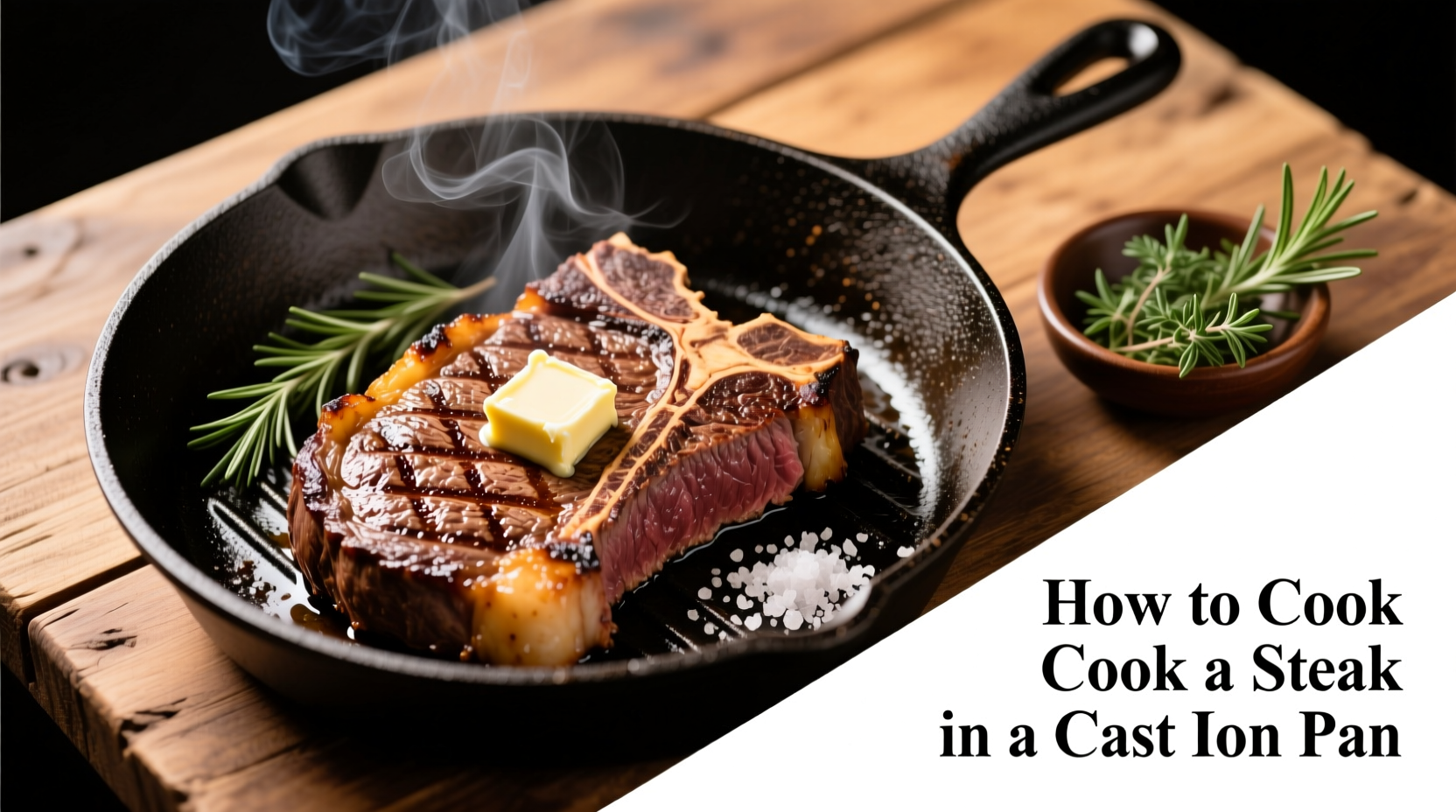The perfect method for cooking steak in a cast iron pan involves bringing the steak to room temperature, seasoning simply with salt and pepper, preheating your pan until smoking hot, searing for 3-4 minutes per side, adding butter and aromatics during the final minutes, and allowing proper resting time before serving. This technique creates a flawless crust while maintaining ideal internal doneness.
Why Cast Iron Reigns Supreme for Steak
Cooking steak in a cast iron pan delivers unmatched results because of its exceptional heat retention and distribution properties. Unlike non-stick alternatives, cast iron can reach and maintain the extremely high temperatures (500°F/260°C+) required for the Maillard reaction—that magical chemical process responsible for the rich, complex crust on properly seared steak.
According to the Culinary Institute of America's research on cooking surfaces, cast iron achieves more consistent browning than stainless steel or carbon steel due to its thermal mass. This means fewer hot and cold spots that can lead to uneven cooking. When properly maintained, a seasoned cast iron pan creates a naturally non-stick surface ideal for achieving that perfect sear without sticking.
Essential Equipment Checklist
Before you begin, gather these critical items:
- 10-12 inch cast iron skillet (pre-seasoned)
- High-heat oil (avocado, grapeseed, or refined peanut)
- Meat thermometer (instant-read recommended)
- Tongs (no piercing required)
- Basting spoon
- Wire rack for resting
Step-by-Step Steak Perfection
Preparation: The Foundation of Success
Remove your steak from the refrigerator 60-90 minutes before cooking. This critical step ensures even cooking throughout. Pat the steak thoroughly dry with paper towels—moisture is the enemy of a proper sear. Season generously with coarse salt and freshly ground black pepper on all sides. For best results, avoid marinades that can interfere with browning.

Preheating: Setting the Stage
Place your empty cast iron pan on the stove over medium-high heat for 5-7 minutes until uniformly hot. Test readiness by sprinkling a few drops of water—they should dance and evaporate instantly. Add 1-2 tablespoons of high-heat oil and swirl to coat the surface. The oil should shimmer but not smoke excessively.
Cooking Process: Timing is Everything
Carefully place the steak in the pan away from you to avoid oil splatter. Do not move it for the first 3 minutes—this allows the crust to form. Flip using tongs and cook for another 3-4 minutes for medium-rare. For thicker cuts (1.5 inches+), finish in a 400°F (204°C) oven.
| Steak Thickness | Rare (120-125°F) | Medium Rare (130-135°F) | Medium (140-145°F) |
|---|---|---|---|
| 1 inch | 2-3 min per side | 3-4 min per side | 4-5 min per side |
| 1.5 inches | 3-4 min + 2-3 min oven | 4-5 min + 3-4 min oven | 5-6 min + 4-5 min oven |
| 2 inches | 4-5 min + 5-7 min oven | 5-6 min + 7-9 min oven | 6-7 min + 9-11 min oven |
During the final 2 minutes of cooking, add 2 tablespoons of butter, 2 crushed garlic cloves, and fresh thyme or rosemary to the pan. Tilt the pan and spoon the melted butter continuously over the steak for enhanced flavor.
Resting: The Critical Final Step
Transfer the steak to a wire rack (not a plate) and let rest for 5-10 minutes—this allows juices to redistribute. Cutting too soon causes precious juices to escape onto your plate rather than staying in the meat. The USDA Food Safety and Inspection Service confirms that resting time is essential for optimal texture and juiciness.
Troubleshooting Common Issues
Problem: Steak sticks to the pan
Solution: Ensure proper preheating and that the steak is completely dry before cooking. Never force a stuck steak—it will release naturally when the crust forms.
Problem: Uneven cooking
Solution: Check your stove's heat distribution. Rotate the pan occasionally during preheating for even temperature.
Problem: Excessive smoke
Solution: Turn on your exhaust fan, open windows, and consider lowering the heat slightly while maintaining proper searing temperature.
When Cast Iron Isn't Ideal: Context Boundaries
While cast iron excels for most steaks, certain situations call for alternative methods. Extremely thin cuts (<1/2 inch) may overcook before developing a proper crust. For delicate fish steaks or very lean cuts that require lower temperatures, stainless steel might be preferable. The American Meat Science Association notes that for cuts with significant marbling like ribeye or strip steak, cast iron remains the optimal choice for home cooking.
Pro Tips for Restaurant-Quality Results
- Use a thermometer: Visual cues can be misleading—rely on internal temperature for accuracy
- Season early: Salt your steak 45 minutes before cooking to enhance flavor penetration
- Don't overcrowd: Cook one steak at a time for optimal searing
- Chill before cooking: For thick cuts, briefly chilling after seasoning helps create a better crust
- Finish with flare: Add a splash of brandy or red wine to the pan after removing the steak for a quick pan sauce
Frequently Asked Questions
Can I use extra virgin olive oil for cooking steak in cast iron?
No, extra virgin olive oil has a low smoke point (around 375°F) and will burn at the high temperatures needed for proper searing. Use high-heat oils like avocado (smoke point 520°F), grapeseed (420°F), or refined peanut oil (450°F) instead.
How do I prevent my steak from sticking to the cast iron pan?
Ensure your pan is properly preheated until water droplets dance on the surface, use enough high-heat oil, and most importantly, don't move the steak during the first 3 minutes of cooking. A dry steak surface is critical—pat it thoroughly with paper towels before seasoning.
Why should I rest my steak after cooking?
Resting allows the muscle fibers to relax and reabsorb juices that have been forced toward the center during cooking. Cutting too soon causes these precious juices to escape onto your plate. The USDA Food Safety and Inspection Service recommends 5-10 minutes of resting time depending on steak thickness.
What's the ideal temperature for cooking steak in cast iron?
Your cast iron pan should reach 500-550°F (260-288°C) before adding the steak. This high temperature is essential for the Maillard reaction that creates the flavorful crust. Use an infrared thermometer to verify pan temperature if possible.
Can I cook a frozen steak in cast iron?
While possible using the reverse sear method, it's not recommended for best results. Frozen steak creates excess moisture that prevents proper searing and leads to uneven cooking. For optimal results, always thaw steak completely in the refrigerator before cooking.











 浙公网安备
33010002000092号
浙公网安备
33010002000092号 浙B2-20120091-4
浙B2-20120091-4